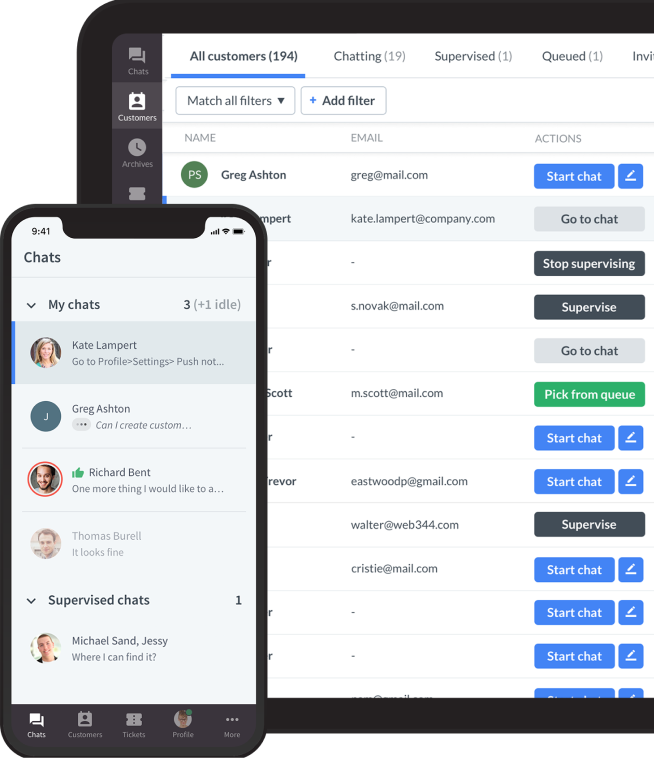
Sentiment analysis plays a crucial role in customer experience management (CEM). Using advanced natural language processing (NLP) techniques, businesses can evaluate the emotional tone and intent expressed in online mentions of their brand, product, or service.
This analysis helps organizations understand how customers perceive them and provides insights on enhancing their online presence. By identifying strengths, weaknesses, and customer preferences, businesses can adapt their offerings, address customer complaints, and improve customer satisfaction.
With the power of sentiment analysis, businesses can effectively manage their brand reputation and deliver exceptional customer experiences. You'll learn more about how sentiment analysis can improve customer experience management and the benefits of using these customer experience analytics solutions.
Customer experience analytics
Customer experience analytics involves gathering and analyzing customer data from social media interactions or website feedback. A comprehensive understanding of customer data is essential to providing a great customer experience.
Contact centers should have actionable data to balance improving customer satisfaction and achieving business goals. Utilizing data enables informed decisions and identifies areas for improvement, such as adding self-service portals or improving training materials to enhance customer service.
Benefits of customer experience analytics
There are several benefits when using customer experience analytics; in this section, we'll cover the top ones.
-
Improved customer insights
Understanding your CX analytics is highly beneficial as it gives you concrete information about how your customers perceive your brand or services and where you can improve.
Analyzing your contact center data lets you gain real-time insights into your customers' thoughts and wants. The more comprehensive your insights and internal data are, the better you can make decisions to enhance customer service.
Analytical tools and AI systems allow you to view each customer journey stage.
You can determine which channels customers use and allocate your resources accordingly.
These tools also allow you to monitor your customers' sentiment and perception of your brand, which your employees' actions can influence.
-
Better training for agents
To run a successful customer experience (CX) strategy, having the right contact center tools and tech is not enough. Having skilled agents who can provide excellent customer service is equally important.
Analyzing how your team interacts with customers can pinpoint where they excel and where they might need a boost in skills like empathy or listening. When you dive into customer data, it lets you spot the usual hiccups and gives your team smart guides to sort out those issues quickly.
-
Lower customer churn
Look at your customer experience analytics, and you'll spot the strengths of your support team while pinpointing where to level up.
Getting a grasp on what your customers like and what they hate can steer you clear of hiccups in their digital experience, keeping them happy and firmly on board.
Customers may stop doing business with companies for a variety of reasons. Identifying the factors that most likely drive your clients away can help you eliminate those problems.
With customer experience analytics, you can recognize recurring issues that customers face. This helps reduce customer churn and create better self-service resources and tools.
With sentiment analysis tools, you can identify customers at risk of leaving in real time.
This can help you guide your agents to de-escalate the situation and increase your chances of retaining the customer.
-
It gives your business an edge
According to Gartner's research, customer experience affects brand loyalty by 60% more than product prices and features.
Analyzing customer experience data can guide you in crafting standout interactions that set your brand apart.
Look into all the data, and you'll spot trends that let you tailor your chat to hit just right with each customer group. It will ramp up your sales game, tipping the odds in your favor to convert more customers.
-
Achieving high revenue
Improving your sales strategies isn't the only way to boost your bottom line. Analyzing customer experience can increase customer satisfaction, leading to higher retention rates and improved lifetime value.
Happy customers tend to spend more on each purchase, increasing order values. Research indicates that customers with a positive experience with a business spend an average of 140% more than those without. So, investing in great customer experiences can have a significant payoff. The most efficient way is using customer experience analytics.
Customer experience analytics to track
You should only measure the customer experience-related KPIs relevant to your business. If you're figuring out which ones to consider, let's cover the two most popular metrics to track.
NPS
The net promoter score (NPS) is a quick and easy way for customers to rate a brand, service, or product.
It consists of only two questions, making it easy for companies to track and analyze. The score provides a single customer experience-related number that leadership can use to set targets and bonuses. The NPS is widely used in many industries to evaluate overall customer satisfaction.
What it can help with:
-
Easy for customers and companies.
-
Open text feedback lets you see the big picture.
-
NPS allows you to predict future revenue gain/loss by monitoring for an increase/decrease.
-
NPS measures word-of-mouth marketing strategies.
Customer satisfaction for easy customer feedback
Customer satisfaction (CSAT) is one of the most commonly used customer experience analytics. It is available in various forms and scales, but the most popular scale is 1 to 5. Google ratings are an excellent example of CSAT.
It is a valuable tool to measure whether a customer is satisfied with a single interaction. It is generally used in customer service or customer support.
CSAT can also be customized to meet the specific requirements of your organization. It is a straightforward and compelling customer experience metric to implement. Like NPS, it is usually quick and straightforward for customers to answer.
Customers are usually asked to assess the efficiency of the customer service department after a transaction or customer support ticket. CSAT is an excellent customer experience analytics tool that determines customers' thoughts about your business.
Managing brand reputation with sentiment analysis
Sentiment analysis is crucial to any online reputation management (ORM) strategy. It analyzes online mentions of a brand using NLP to gauge emotional tone and intent.
It helps organizations to understand how their customers perceive them online and how they can improve their online presence.
By analyzing the sentiment of online mentions, businesses can identify their strengths and weaknesses, address customer complaints, and ultimately enhance customer satisfaction.
It also helps keep an eye on trends and customer preferences, which allows businesses to stay ahead of their competition.
Identifying trends
Understanding sentiment can be the key to helping a company be adaptable to the ever-changing market dynamics. For example, restaurants can quickly alter menus if a dish receives glowing reviews.
At the same time, retail outlets can redistribute stock if there is an unexpected surge in demand for a certain product.
Brands that listen to customers and adapt their offerings to consumer expectations accordingly stand to gain customer loyalty and market share.
Real-time trend identification
Traditionally, businesses relied on delayed reports and gut instinct to identify trends. Sentiment analysis, however, provides a real-time view of customer satisfaction. As customer feedback is analyzed as it comes in, brands can swiftly pinpoint and act upon emerging trends.
This helps to react quickly to changes in customer sentiment, which can be the difference between a market leader and a follower. For instance, a new product feature that customers are raving about can be rapidly promoted, or a service issue causing negative sentiment can be immediately addressed.
Customer journey mapping
You will have valuable insights after deciding your goals, mapping your customer journey, and analyzing data. It is important to identify the pain points or problem areas that are hindering the customer journey.
For instance, if your Google Adwords landing page has a poor user experience, it may prevent leads from moving to the free trial signup page.
In such a scenario, you should improve the Adwords landing page UX to increase the number of leads that click on your free trial signup page.
Google Analytics and similar platforms can help you diagnose the exact part of the customer journey with issues, ensuring that you devote your time to the right things and don't waste time trying to fix areas that need improvement.
Also, apart from identifying areas of improvement, it is essential to pay attention to the steps in the entire customer journey that are working. This knowledge will help you to focus on what customers are responding to so that you can double down on those areas.
Multilingual settings
Multilingual sentiment analysis, or multilingual opinion mining, is social listening. Social listening involves monitoring and analyzing conversations across various social media platforms to identify sentiment, causes, public opinion, and social trends.
Within this area, sentiment analysis focuses on identifying, extracting, analyzing, and labeling the emotions and opinions expressed by consumers on social media. Multilingual sentiment analysis refers to when sentiment analysis is conducted in more than one language.
Since 4.8 billion people actively use social media and only 25.9% of internet users are native English speakers, multilingual sentiment analysis is becoming increasingly important in social listening.
What languages can sentiment analysis work with?
Language detection is a fundamental step in sentiment analysis as it helps to interpret the sentiment of a social media post. Sentiment analysis models must identify the language used in a post to decipher the sentiment information.
However, involving human linguists to translate foreign-language social media posts into English for sentiment scoring is not feasible.
Therefore, sentiment scoring systems of companies that operate internationally face one of the most common challenges in sentiment analysis: their existing systems are not trained to analyze sentiment for languages other than English.
Challenges of multilingual sentiment analysis
The limitations of NLP techniques and open-source tools pose challenges for multilingual sentiment analysis in global marketing.
The need for training
Sentiment analysis tools are designed to classify words and phrases within a particular language. However, when these tools are used with other languages, they may need to have the necessary language-specific training data, leading to lower accuracy and reliability.
As a result, one of the most common challenges for companies operating internationally is that their sentiment scoring systems are not trained in sentiment analysis for languages other than English.
Machine translation
Machine translation technology is not capable of detecting sarcasm or irony in text.
Sentiment analysis, which requires understanding the text in context, is better performed by sentiment scoring models trained in sentiment analysis for each language.
However, for basic sentiment analysis (positive versus negative), sentiment analysis tools that use both machine learning and translation can effectively learn sentiment from translated text.
Privacy and biases
The violation of data privacy regulations and unauthorized use of sensitive customer data can end up with severe legal and reputational consequences.
Sentiment analysis models can sometimes be biased due to labeling and training data inconsistencies, leading to inaccurate and unfair results.
Conclusion
In the current customer experience-oriented economy, businesses focusing on understanding customer expectations and catering to customer sentiment are more likely to succeed.
That is why sentiment analysis is vital for learning more about the customer.
It will allow you to get the data you need to make better business plans and focus on improvements for better customer acquisition, customer retention, and experience management.
Get a glimpse into the future of business communication with digital natives.
Get the FREE report




